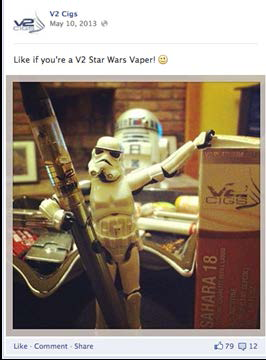April 17, 2014
Stanton A. Glantz, PhD
Important report on e-cig company promotions directed at youth
On April 14, 2014, several members of Congress released an important report, Gateway to Addiction: A Survey of Popular Electronic Cigarette Manufacturers and Targeted Marketing to Youth, in which they surveyed the major e-cigarette companies about their advertising and promotional activities (and, when the companies ignored requests for information collected information directly from their websites and other sources). The report' findings are:
Major findings:
- All surveyed companies appear to use various marketing practices that appeal to youth. For instance:
- Eight e-cigarette companies promote their products through sponsored or sampling events, many of which appear to be youth-oriented. In 2012 and 2013alone, six of the surveyed companies sponsored or provided free samples at 348 events.
- Seven e-cigarette companies air television and radio advertisements during events and programs, including those with youth viewership. Blu’s commercials “have aired thousands of times at various times of the day and night on 48 networks,”and NJOY has advertised during programs including the Super Bowl, an eventthat reaches a substantial audience of youth under age 18.
- Six e-cigarette companies market e-cigarettes in flavors that could appeal to children and teens. For example, e-cigarette manufacturers are marketing flavors like Cherry Crush, Chocolate Treat, Peachy Keen, and Grape Mint.
- E-cigarette manufacturers have significantly increased marketing spending, more than doubling expenditures between 2012 and 2013. In total, six e-cigarette companies spent $59.3 million in 2013 to market e-cigarettes.
Additional findings:
- There is wide variation in e-cigarette industry point-of-sale practices. One e-cigarette company reported that it does not maintain any policy barring sales to minors. Other companies have policies barring such sales, but these vary in scope and the level of company oversight.
- Four e-cigarette companies use celebrity spokespeople to market their products and depict e-cigarette smoking as glamorous. For example, celebrities have appeared in advertisements and at a prominent music festival.
- Seven e-cigarette companies utilize social media to promote their products. While some companies impose age restrictions to prevent youth access to their Facebook, Twitter, and YouTube content, three companies – Eonsmoke, VMR, and Lead by Sales – do not utilize any age restriction options for social media accounts.
- E-cigarette product warning labels lack uniformity and may confuse consumers. While some manufacturers' warning labels are succinct, make clear that e-cigarettes don't offer health benefits, and detail the health risks associated with nicotine, others do not.
- Six e-cigarette companies support some form of regulation, such as restrictions on the sale and marketing of e-cigarettes to children and teenagers, a ban of the usage of television to market e-cigarettes, a prohibition on characterizing flavors, restricting online sales, and regulation of e-cigarettes at the point-of-sale.
The report also has several examples of e-cigarette advertsing (figure) which are clearly directed at middle aged adults interested in using e-cigarettes for harm reduction.
A rhetorical question: Why isn't the FDA doing this?
The rhetorical answer: The White House won't let them.


Add new comment